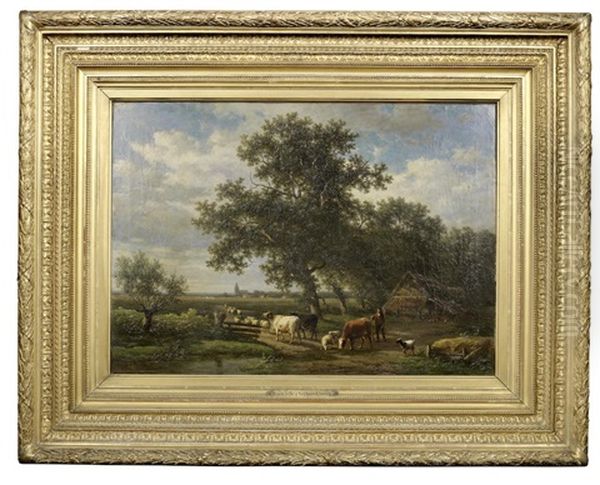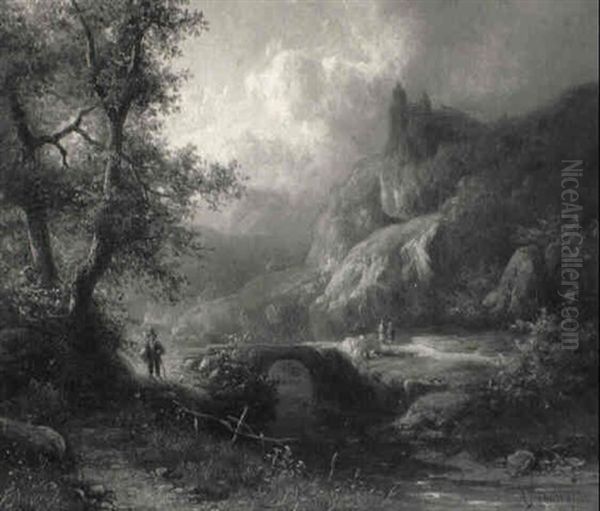Alexander Joseph Daiwaille (1818-1888) was a distinguished Dutch painter, primarily celebrated for his evocative landscape scenes. Operating during the vibrant period of 19th-century European Romanticism, Daiwaille carved a niche for himself with his meticulous attention to detail and his ability to capture the serene, and sometimes dramatic, beauty of nature. His life and work were deeply intertwined with some of the most prominent artistic figures of his time, particularly within the rich tradition of Dutch landscape painting that had flourished for centuries.
Early Life and Artistic Beginnings
Born in Amsterdam on January 21, 1818, Alexander Joseph Daiwaille was immersed in an artistic environment from a young age. His father was Jean Augustin Daiwaille (1786-1850), a respected portrait painter and printmaker who also served as a director of the Rijksakademie van beeldende kunsten (Royal Academy of Fine Arts) in Amsterdam. This familial connection undoubtedly provided young Alexander with early exposure to artistic techniques and the professional art world.
His formal artistic education commenced between 1820 and 1826 at the prestigious Amsterdam Royal Academy of Arts. During this formative period, he studied under the tutelage of his father, Jean Augustin Daiwaille, and also received instruction from Jan Willem Pieneman (1779-1853). Pieneman was a highly influential figure in Dutch art, known for his large-scale historical paintings, including the famous "The Battle of Waterloo," and his directorship at the Academy. This early training would have grounded Daiwaille in the academic principles of drawing and composition, essential foundations for his later specialization in landscape.
The Pivotal Influence of Barend Cornelis Koekkoek
A defining chapter in Daiwaille's artistic development and personal life was his association with Barend Cornelis Koekkoek (1803-1862). Koekkoek, often hailed as the "Prince of Landscape Painters," was arguably the most celebrated Dutch Romantic landscape artist of his generation. Daiwaille became not only a student of Koekkoek but also a close family member. In 1833, Alexander Joseph Daiwaille married Elise Therese Koekkoek, Barend Cornelis Koekkoek's daughter, thus becoming his son-in-law.

This relationship extended into a professional mentorship. Daiwaille moved to Cleves (Kleve), Germany, where Koekkoek had established his studio and, in 1841, founded a drawing academy known as the "Zeichen Collegium." Daiwaille studied and worked closely with Koekkoek in Cleves for a significant period, reportedly for seven years, until around 1847. This immersion in Koekkoek's circle was profoundly influential. Koekkoek's style, characterized by its idealized yet meticulously detailed depictions of nature, majestic trees, atmospheric light, and often picturesque ruins or staffage, left an indelible mark on Daiwaille's own artistic vision.
The Zeichen Collegium in Cleves, under Koekkoek's direction, became a hub for aspiring landscape painters. Daiwaille, alongside his mentor, played a role in this educational endeavor, contributing to the training of many young artists. Among those associated with Koekkoek's school and influence were artists like Marinus Adrianus Koekkoek (B.C. Koekkoek's brother) and Johann Bernard Klombeck (1815-1893), who himself became a renowned landscape painter, often collaborating with Koekkoek and sharing a similar romantic sensibility.
Artistic Style and Thematic Preferences
Alexander Joseph Daiwaille's oeuvre firmly places him within the Dutch Romantic landscape tradition. This movement, while drawing inspiration from the legacy of 17th-century Dutch Golden Age masters like Jacob van Ruisdael and Meindert Hobbema, infused landscapes with a heightened emotional sensibility, an appreciation for the sublime or picturesque qualities of nature, and often a nostalgic or idealized vision.
Daiwaille excelled in capturing the nuanced beauty of both summer and winter landscapes. His summer scenes are often lush and verdant, featuring tranquil rivers, dense forests, and sometimes architectural elements like distant castles or rustic cottages that add a narrative or picturesque quality. His winter scenes, a popular subgenre in Dutch Romanticism partly due to the influence of painters like Andreas Schelfhout (1787-1870), often depict snow-covered terrains, frozen waterways with skaters, and the stark, delicate beauty of trees in their dormant state.
His technique was characterized by a fine, detailed brushwork, a careful rendering of foliage, water, and atmospheric effects. Like his father-in-law, B.C. Koekkoek, Daiwaille paid close attention to the play of light and shadow, using it to create depth and mood in his compositions. His works often evoke a sense of peace and harmony, inviting the viewer to contemplate the serene beauty of the natural world. While his landscapes are often idealized, they are grounded in careful observation of natural forms.
Collaborations and Professional Engagements

The 19th-century art world often saw collaborations between artists who specialized in different areas. Alexander Joseph Daiwaille participated in such practices. Notably, around 1850, he collaborated with the esteemed Belgian animal painter Eugène Verboeckhoven (1798-1881). Verboeckhoven was renowned for his masterful depiction of livestock, particularly sheep and cattle, and he frequently added animal staffage to the landscapes of his contemporaries. Their joint work, "Going to Pasture," exemplifies this synergy, with Daiwaille likely providing the landscape and Verboeckhoven the expertly rendered animals. This collaboration also highlights Daiwaille's connections beyond the Dutch art scene, extending into Belgium, another important center for Romantic painting.
Daiwaille also held a position as one of the directors at the Royal Academy of Arts in Amsterdam for a period. However, sources suggest he eventually left this role due to dissatisfaction with the work, choosing instead to focus more on his printmaking and painting. His involvement in printmaking, like his father and B.C. Koekkoek, who also produced influential series of lithographs for study purposes, underscores a commitment to the dissemination of artistic knowledge and imagery. He and Koekkoek jointly produced several series of landscape lithographs and published books on landscape studies, further contributing to art education.
Notable Works and Collections
Several of Alexander Joseph Daiwaille's works are recognized for their characteristic charm and technical skill. While many are in private collections, some have found their way into public or notable institutional holdings.
One such representative piece is "Rivierlandschap met reizigers en een herder met zijn kudde" (River Landscape with Travellers and a Shepherd with his Herd). This painting, measuring 26.4 x 33 cm, is currently in a private collection. The title itself suggests a typical Romantic composition: a serene river scene populated with figures that add life and a narrative touch, a common feature in the works of both Daiwaille and Koekkoek.
Another significant work is "Paysage de château" (Castle Landscape). This larger painting, 73 x 52.5 cm, is housed in the Twickel Foundation in Delden, Netherlands. The depiction of a castle within a landscape was a popular Romantic motif, evoking a sense of history, grandeur, and often a touch of melancholy or nostalgia. The specific creation date for this piece is cited in one source as 1535, which is clearly an error and likely refers to a different artwork or a typographical mistake, as Daiwaille was a 19th-century painter. His works generally fall within the mid-1800s.
The collaborative piece "Going to Pasture," created with Eugène Verboeckhoven, is also held in a private collection. Such works are valuable not only for their artistic merit but also for the insight they provide into the collaborative practices of the era.
Daiwaille's talent did not go unnoticed by prominent patrons. In 1847, his work was acquired by King Willem II of the Netherlands, a significant art collector. Royal patronage was a mark of high distinction and would have considerably enhanced an artist's reputation.
Later Career, Relocation, and Legacy
After his productive years in Cleves, Daiwaille returned to the Netherlands. Later in his life, he moved to Brussels, Belgium, where he passed away in 1888. Brussels at the time was a thriving artistic capital, and his relocation there suggests an engagement with its vibrant art scene, which included prominent figures like the history and genre painter Henri Leys (1815-1869), a contemporary of Verboeckhoven.
Alexander Joseph Daiwaille's legacy lies in his contribution to the Dutch Romantic landscape tradition. While perhaps not reaching the towering fame of his father-in-law, B.C. Koekkoek, he was a highly skilled and respected painter who produced a significant body of work characterized by its sensitivity to nature, technical finesse, and adherence to the Romantic aesthetic. His paintings continue to be appreciated for their tranquil beauty and their embodiment of 19th-century landscape ideals.
He was part of an extensive artistic network that included not only his father Jean Augustin Daiwaille and the influential Koekkoek family (which included other notable painters like Hermanus Koekkoek Sr., a marine painter, and Marinus Adrianus Koekkoek) but also other contemporaries. The Dutch art scene of his time featured other notable Romantic landscape painters such as Wijnand Nuijen (1813-1839), whose early death cut short a promising career, and Salomon Leonardus Verveer (1813-1876), known for his lively town and seascapes. Daiwaille's interactions, whether as a student, teacher, collaborator, or peer, placed him firmly within this dynamic artistic milieu. Figures like Henry Campotosto and Louis Pierre Vernet were also part of the broader European artistic circles of the period, though their direct interactions with Daiwaille are less specifically documented in the provided information.
Conclusion: An Enduring Romantic Vision
Alexander Joseph Daiwaille stands as a noteworthy figure in 19th-century Dutch art. His dedication to landscape painting, shaped by familial ties, esteemed mentors like Barend Cornelis Koekkoek, and collaborations with artists such as Eugène Verboeckhoven, resulted in a body of work that reflects the core tenets of Romanticism. His depictions of serene summer days, crisp winter scenes, and picturesque river valleys, often imbued with a gentle, contemplative mood, offer a window into the 19th-century appreciation for the beauty and emotional resonance of the natural world.
His role as an educator, both informally through his association with Koekkoek's academy and formally through his directorship at the Amsterdam Royal Academy, also contributed to the continuation of artistic traditions. Though perhaps overshadowed by some of his more famous contemporaries, Alexander Joseph Daiwaille's paintings remain a testament to his skill and his commitment to the Romantic landscape, securing his place in the annals of Dutch art history. His works continue to be sought after by collectors and admired by those who appreciate the refined beauty of 19th-century landscape art.